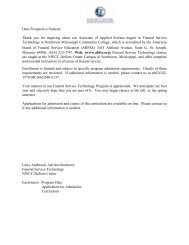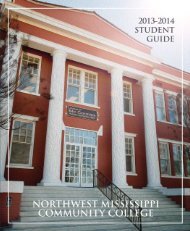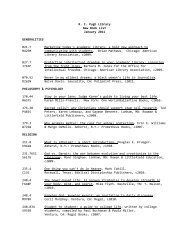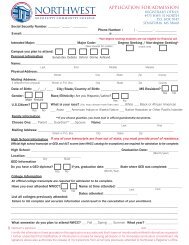Coping with Seven Disruptive Personality Types in the Classroom
Coping with Seven Disruptive Personality Types in the Classroom
Coping with Seven Disruptive Personality Types in the Classroom
Create successful ePaper yourself
Turn your PDF publications into a flip-book with our unique Google optimized e-Paper software.
IntroductionThe typical college professor is bound to run <strong>in</strong>to his or her share of difficult students dur<strong>in</strong>g<strong>the</strong> course of an academic career. Some students create nuisances by engag<strong>in</strong>g <strong>in</strong> annoy<strong>in</strong>gbehavior, such as <strong>in</strong>terfer<strong>in</strong>g <strong>with</strong> classroom proceed<strong>in</strong>gs, mak<strong>in</strong>g irrelevant comments, andcaus<strong>in</strong>g noisy <strong>in</strong>terruptions. They may turn assignments <strong>in</strong> late, disregard <strong>the</strong> courseexpectations, and <strong>in</strong>sist on special treatment for <strong>the</strong>mselves. O<strong>the</strong>r students, however, maypose a very real threat to <strong>the</strong> safety of <strong>the</strong> professor and fellow students.Relatively few college professors are tra<strong>in</strong>ed <strong>in</strong> how to recognize and respond effectively to<strong>the</strong>se challeng<strong>in</strong>g or threaten<strong>in</strong>g behaviors. Sometimes, faculty members will have difficultydist<strong>in</strong>guish<strong>in</strong>g between a student who is a mere nuisance and a student who poses a veryreal hazard to <strong>the</strong> community. It is comfort<strong>in</strong>g to know that many of <strong>the</strong> most difficult anddisruptive encounters <strong>with</strong> students tend to fall <strong>in</strong>to predictable, known categories.This white paper will also help you to set enforceable standards, expectations, andboundaries flexibly <strong>with</strong> students, depend<strong>in</strong>g on <strong>the</strong> exhibited personality style.After read<strong>in</strong>g this white paper, you will know how to better manage passive-aggressivebehaviors such as sleep<strong>in</strong>g <strong>in</strong> class, lateness, and procrast<strong>in</strong>ation. You will learn essentialpr<strong>in</strong>ciples regard<strong>in</strong>g <strong>the</strong> value of collaborat<strong>in</strong>g <strong>with</strong> on-campus resources to resolvedisruptive crises. This white paper also provides guidance to help professors know whe<strong>the</strong>rand when <strong>the</strong>y need to report certa<strong>in</strong> disruptive <strong>in</strong>cidents.Perhaps most important, this report provides <strong>the</strong> guidance necessary to help <strong>in</strong>structors andadm<strong>in</strong>istrators recognize “red flags” that portend physical risk when deal<strong>in</strong>g <strong>with</strong> potentiallydangerous students.The seven disruptive personality styles are: explosive, antisocial, passive-aggressive,narcissistic, paranoid, litigious, and compulsive.We will cover each personality style <strong>in</strong> turn and <strong>the</strong>n look at likely situations <strong>in</strong> which eachcould manifest troublesome behavior <strong>in</strong> <strong>the</strong> classroom and elsewhere on campus. We will<strong>the</strong>n suggest various ways for <strong>in</strong>structors to respond effectively to disruptive studentsaccord<strong>in</strong>g to <strong>the</strong> students’ personality style.Before proceed<strong>in</strong>g, a few words of explanation are <strong>in</strong> order. First, it is important tounderstand that <strong>the</strong> personality styles described here<strong>in</strong> are not cl<strong>in</strong>ical diagnoses orpsychiatric designations. In o<strong>the</strong>r words, <strong>the</strong>re is noth<strong>in</strong>g especially scientific, medical, or5




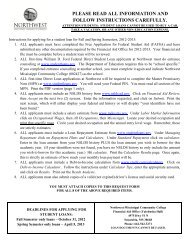




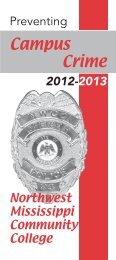

![Pro-Dental Hygiene [Major Code T34] - Northwest Mississippi ...](https://img.yumpu.com/35524032/1/190x149/pro-dental-hygiene-major-code-t34-northwest-mississippi-.jpg?quality=85)
